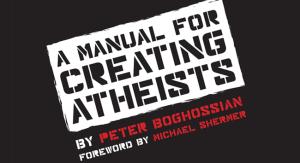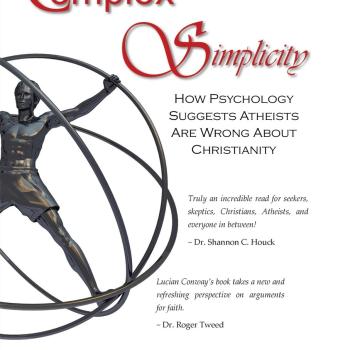
Peter Boghossian is a philosopher and college professor who is responsible for inventing the practice of “Street Epistemology.” Street Epistemology is the atheist version of Street Evangelism, meaning that it is a cold approach in a public forum, wherein an atheist approaches a religious person and employs tactics to talk the person out of his or her religious belief.
As a deconversion researcher, it is of interest to me as to how effective Street Epistemology is, and what Boghossian had to say in his book on the subject, A Manual for Creating Atheists.
The book, as it happens, did not contain much of interest to a deconversion researcher. The largest portion of the “manual” involved voicing Boghossian’s distaste for and concerns about religious faith, which he describes as “pretending to know something you don’t.” Boghossian spends a goodly portion of the book illustrating the dangers of faith, arguing against alternative definitions of faith, and shooting down arguments for why he and others should not do what he calls “interventions” to disabuse religious individuals of their faith.
The portion of the book which actually dealt with tactics for talking people out of their faith was insubstantive, and I ultimately learned more from watching videos of Street Epistemologists in action than I did from his book.
Faith as Epistemology
The book did, however, fill a big hole that I have been working to fill almost since I began my research. That hole involves the level of confidence or certainty which seems like a significant factor in deconversion. In order to discuss this, I will first need to define what is meant by the word “epistemology.” Put simply, “epistemology” refers to how a person comes to know something. Hearsay is a common epistemology, meaning that one trusts what one is told by friends, teachers, or news outlets. Science is a kind of epistemology, meaning that one observes and tests things before coming to conclusions.
Boghossian argues that Faith is a kind of epistemology. By this, he means that a person believes a thing for the sake of belief, and becomes confident that something is true simply by pretending that it is true. By framing faith as an epistemology, the author puts his finger on the pulse of this problem. If one believes that the way in which he or she can be confident of the truth of their religious system is by means of faith in the truth of scripture, the authority of the spiritual leader, their personal religious experiences, the strength of tradition and so forth, when someone demands evidence beyond mere belief, the person comes up short.
Under different conditions, the person’s strength of conviction might be enough to hold up under such demands, but when the audience (the street epistemologist) is not receptive to the kind of evidence one might ordinarily supply, confidence is shaken. And when one’s religious beliefs demand a high level of confidence (as various religious environments do when they reference faith), this might serve as a “trigger” to begin the deconstruction process.
Your “man on the street” Christian would not be able to supply the sort of scholarly and scientific evidence that a Christian Apologist might, claiming that these, not blind adherence, were the means by which they came to their beliefs. If the person’s belief was built on an epistemology more similar to scholarship or science, then the method of the Street Epistemologist might be stymied.
Faith and Pretending
A second thing that the book brought to light is the other definition he gives of faith, being “pretending to know something you don’t know.” Now the word “pretending” in that definition is problematic given that it indicates that religious people are being actively deceptive. And this isn’t an uncommon idea, especially among deconverts who, at some stage in the deconversion, began to pretend rather than believe, as a method of saving face as their doubts overcame their convictions.
But, wrong or not, most Christians are sincere. At worst, they are mistaken about things they think they understand.
However, one sees a great deal of the visible deconversion coming from individuals involved in ministry. In reports on deconversion of this kind, the former ministers will frequently relate a moment at which people were coming to them for answers, and they didn’t know the answers. But because people relied on them and they didn’t want to let people down, they faked their way through in order to provide comfort and guidance expected of them.
Further, they began to teach and preach on things they no longer believed. So at some point between being Christian and becoming an atheist, they truly DID pretend to know things they did not know. That definition would match the experiences of many former Christians.
Defining Faith
In his debate with Boghossian, Tim McGrew spent most of his time focused on Peter’s definitions of faith. As well he should. Peter’s entire philosophy and principle relied on his non-standard idea of faith. Nonetheless, Peter has managed to identify something endemic to certain strains of fundamentalism, namely, “Faith” is synonymous to “Confidence.” Without faith, one cannot be confident, and without confidence, one is being unfaithful. This is a factor embedded in a certain way of thinking on the Christian side, and whether he realizes it or not, Boghossian has managed to harness it and use it as a trigger to begin the process of deconversion.
Reports I have received indicate that Street Epistemology actually works. The reason it works, I suspect, is that it removes what I call the “preventative principle,” meaning the construct that forbids the individual from critically examining their beliefs.
It would be simplistic to say that the principle is “faith,” but rather that in which the faith is invested. Whether the faith is invested in an individual (a pastor, for instance) a personal experience, the Bible, or whatever else is the maintaining aspect of the person’s religious beliefs or behavior, when confidence in that principle is removed, the individual now has intellectual permission to ask the hard questions they would not have otherwise asked.
While I doubt that the technique is 100% effective, it is bound to select individuals who have experienced “stressors,” meaning questions or difficulties which have remained unexamined due to the preventative principle.
Street Epistemology
Interestingly, the book How Minds Change by David McRaney – written about ten years after A Manual for Creating Atheists – does a much better job of defining and describing the technique of Street Epistemology than does Boghossian’s book which allegedly started the movement. Street Epistemology (SE) uses several tried-and-true techniques in unison, along with its own unique maneuver in order to change minds.
The first of these techniques is one developed by the late Sigmond Freud in his psychoanalysis: the non-threatening audience. What this means is that the listener, in this case the street epistemologist, is listening, accepting, nonjudgmental, and invites the person to open up without being judged for the ideas he or she expresses. Anything less open will put the participant on guard and create resistance to the process.
The second of these techniques is a basic therapeutic tactic known as “active listening.” Under this tactic, street epistemologists repeat and summarize what they have heard in their own words. This allows the participant to correct misunderstandings and expand on his or her ideas. It invites further discussion again, without the resistance of judgment or condemnation.
The third technique comes from the ancient Greek philosopher Socrates, and the technique named after him: the Socratic method. The Socratic method involves questioning back along a people’s lines of reasoning until they reach a point wherein they are working off assumptions they cannot support:
“I believe in God.”
“Why do you believe in God?
“Because he worked in my life.”
“How do you know he worked in your life?”
“Because I’ve felt him working in my heart.”
“How do you know those feelings came from God?”
“I… just know!”
All of the techniques described above were invented by others and have proven effective over the years. However, the new tactic created by street epistemologists (although not actually described in Boghossian’s book) is to target the issue of certainty. Among the questions Street Epistemologists are instructed to ask is “On a scale of 1 to 10, how certain are you.” This question is introduced in relation to any religious idea that the targeted individual holds. Whether the issue is the truth of the Bible, the actuality of Creationism, or the resurrection of Jesus – if they make a religious claim SE will demand a level of certainty.
The genius behind this technique is that it targets one of the five modes of religious exercise common to potential deconverts: compulsive certainty.
Individuals who deconvert tend to come from a religious environment wherein high confidence if not absolute certainty is demanded of them. One must be certain of one’s salvation. One must have “confidence in Christ,” or lean with certainty on the promises of scripture.
This is easy enough in a religious environment wherein everyone around you reinforces your beliefs, but when confronted by some individual who does not hold to your beliefs, that sense of confidence which is largely emotionally maintained becomes shaky. And in that moment when the individual realizes that they can’t with any integrity meet the demand of total confidence, it can be something of a revelation.
The second way in which SE can be effective is that it tends to remove the preventative principle, meaning that circumstance which prevents the target from asking questions about their religious beliefs.
Preventative principles include things like environmental reinforcement: I don’t ask questions because everyone around me believes, or guilt: I don’t ask questions because it would be sinful or disloyal, or fear: I don’t ask questions because I am afraid of the consequences if I do, or, as addressed above, certainty. I don’t ask questions because I am already certain.
SE isolates the targeted individual away from peers who might otherwise work to reinforce their confidence. The questions are geared in the direction of causing the targets to realize that they believe because they have been told rather than because they have thought things through on their own. This undercuts loyalty and guilt.
Once the preventative principle is removed, targets now have intellectual permission to ask the questions they have avoided asking in the past. And it just so happens that there is someone standing right in front of them to assist them with asking those questions.
SE undercuts the sorts of things which have prevented the individual from exploring his or her doubts while simultaneously reinforcing those doubts.
Ultimately, SE serves as an effective trigger which plays on an individual who has had enough establishing conditions to make him or her potential deconverts.













